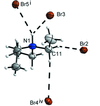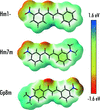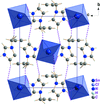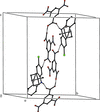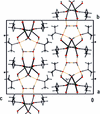issue contents
October 2020 issue

Cover illustration: Even in the absence of high-quality single crystals, three-dimensional structural information may still be accessible. Using home-laboratory powder X-ray diffraction, Rietveld refinement, and optimization by density-functional theory calculations, the structures of disodium hydrogen citrate monohydrate, Na2HC6H5O7(H2O), and diammonium sodium citrate, (NH4)2NaC6H5O7, have been solved and refined. See: Hong, Bhaskar, Golab & Kaduk [Acta Cryst. (2020). E76, 1572–1578].
research communications
Download citation


Download citation


The title compounds, [Ir(C51H64N2)(C8H12)Cl]·CH2Cl2 and [Ir(C51H64N2)(C8H12)Cl], represent the first two examples of hexahydrobenzoimidazole-based N-heterocyclic carbene (NHC) iridium complexes. The diastereomeric complexes differing only in their axial chirality, which could be separated via column chromatography, show noticeable differences in their 1H NMR spectra.
Download citation


Download citation


The synthesis and crystal structure of the spiro title compound is presented.
CCDC reference: 1983982
Download citation


Download citation


The title compound crystallizes with a single molecule in the asymmetric unit. The phenol ring makes a dihedral angle of 36.56 (3)° with the nitrobenzene ring. In the crystal, molecules are linked by C—H⋯O interactions, forming chains along the b-axis direction.
CCDC reference: 2025323
Download citation


Download citation


The title compound was synthesized by a new type of reaction using Mg(ReO4)2 as a new catalyst and a possible mechanism for this reaction is proposed. In the crystal, hydrogen bonds connect the molecules into double layers, which are connected to each other by halogen bonds.
CCDC reference: 2025758
Download citation


Download citation


The synthesis and characterization of a new titanocene dichloride complex with tert-butyl esters appended to the cyclopentadiene rings is reported.
CCDC reference: 2025817
Download citation


Download citation


The crystal structures of the isostructural mixed-cation compounds dipotassium rubidium citrate monohydrate and potassium dirubidium citrate monohydrate have been solved and refined using laboratory X-ray powder diffraction data and optimized using density functional techniques.
Download citation


Download citation


The crystal structures of disodium hydrogen citrate monohydrate and diammonium sodium citrate have been solved and refined using laboratory X-ray powder diffraction data and optimized using density functional techniques.
Download citation


Download citation


A novel bis(anil) compound was synthesized and structurally characterized. Theoretical calculations suggested that the new bis(hydroxyimine) will exhibit histone deacetylase SIRT2, histone deacetylase class III and histone deacetylase SIRT1 activities, and will act as inhibitor to aspulvinone dimethylallyltransferase, dehydro-L-gulonate decarboxylase and glutathione thiolesterase.
CCDC reference: 2019265
Download citation


Download citation


The ferrocene-bridged compound 1,1′-bis(pyridyltriazoylmethyl)ferrocene acquires an anti conformation in its solid state but forms a discrete tetranuclear [2 + 2] complex with [Cu(CH3CN)4](PF6) in solution.
CCDC reference: 2026000
Download citation


Download citation


The synthesis and crystal structure determination of (Et3NH)2[UBr6]·CH2Cl2 is reported.
CCDC reference: 2025374
Download citation


Download citation


In the crystal, the molecules are linked by C—H⋯N and weak C—H⋯π hydrogen bonds and very weak π–π stacking interactions. Two-dimensional fingerprint plots show that the largest contributions to the crystal stability come from H⋯H and C⋯H/H⋯C interactions.
CCDC reference: 1979807
Download citation


Download citation


In the crystal, molecules are linked by C—H⋯π interactions, resulting in the formation of sheets along the a-axis direction. Within the sheets, very weak π–π stacking interactions occur. The Hirshfeld surface analysis and fingerprint plots reveal that the crystal structure is dominated by H⋯H (37.1%) and C⋯H (30.1%) contacts.
CCDC reference: 2026445
Download citation


Download citation


The structure of three functionalized chalcones (1,3-diarylprop-2-en-1-ones), containing combinations of nitro and dimethylamino functional groups, are presented.
Download citation


Download citation


Two new substituted propanedioate esters have been synthesized using a three-component solvent-free thermal reaction. The products, which are isomorphous, differ only in the presence of a bromophenyl group in one, where the molecules are fully ordered, as compared with a chlorophenyl group in the other, where the molecules exhibit two types of disorder.
Download citation


Download citation


The crystal structures of magnesium hydrogen citrate dihydrate and bis(dihydrogencitrato)magnesium have been solved and refined using synchrotron X-ray powder diffraction data, and optimized using density functional theory techniques.
Download citation


Download citation


The synthesis and crystal structures of three new disubstituted [13]-macrodilactones, trans-4,8-dimethyl-1,10-dioxacyclotridec-5-ene-2,9-dione, cis-4-(4-bromophenyl)-13-methyl-1,10-dioxacyclotridec-5-ene-2,9-dione, and trans-11-methyl-4-phenyl-1,10-dioxacyclotridec-5-ene-2,9-dione are reported and their conformations are put in the context of other [13]-macrodilactone structures reported previously, showing that the number, location, and relative disposition of groups attached at the termini of planar units of the [13]-macrodilactones subtly influence their aspect ratios.
Download citation


Download citation


The title structure consists of isolated [SnCl6]2− octahedral anions separated by layers of organic 1-(prop-2-en-1-yl)-1H-imidazol-3-ium (C6H9N2)+ cations. The crystal packing features intermolecular N—H⋯Cl and C—H⋯Cl hydrogen bonds and π–π stacking interactions.
CCDC reference: 2021940
Download citation


Download citation


The title compound features a very short, but asymmetric, O—H⋯O hydrogen bond having an O⋯O distance of 2.452 (3) Å within the anion.
CCDC reference: 2027224
Download citation


Download citation


Cubic K2Ni0.5Hf1.5(PO4)3 crystallizes in the langbeinite structure type. The principal building units are two independent [(Ni,Hf)O6] octahedra, [PO4] tetrahedra and [KO9] and [KO12] polyhedra.
CCDC reference: 2026681
Download citation


Download citation


Single-crystals of thallium(I) iodide oxide Tl3IO were obtained as by-product in a hydroflux synthesis at 473 K for 10 h. The oxygen atoms center thallium octahedra. The [OTl6] octahedra share trans faces, forming a linear chain along [001]. Twelve thallium atoms surround each iodine atom in an [ITl12] anti-cuboctahedron. Thallium and iodine atoms together form a hexagonal close-sphere packing, in which every fourth octahedral void is occupied by oxygen.
CCDC reference: 2030857
Download citation


Download citation


In the title bicyclic trinuclear pyrazolate aminoalcohol complex, the central Cu atom lies on a center of symmetry and has a distorted tetrahedral coordination geometry while the peripheral Cu atom is in a trigonal–bipyramidal coordination environment.
CCDC reference: 2030043
Download citation


Download citation


The crystal of the melaminium salt C3H7N6+·NCCH2COO−·H2O was produced by mixing melamine with cyanoacetic acid in aqueous solution. The melaminium cations are interconnected by N—H⋯N hydrogen bonds, forming tapes. These tapes of melaminium cations develop a three-dimensional network through multiple donor–acceptor hydrogen-bonding interactions between the cyanoacetate anions and water molecules.
CCDC reference: 2030784
Download citation


Download citation


In the crystal, two molecules of the title compound form an inversion dimer, through C—H⋯π interactions, which further interacts with adjacent dimers to form a one-dimensional column structure.
CCDC reference: 2031765
Download citation


Download citation


Short syntheses to high Fsp3 index natural-product analogues such as iminosugars are of paramount importance in the investigation of their biological activities and reducing the use of protecting groups is an advantageous synthetic strategy. In this case only an isopropylidene group was employed towards the synthesis of seven-membered ring iminosugars.
CCDC reference: 1968033
Download citation


Download citation


The molecular and crystal structure as well as the Hirshfeld surface were analysed for this benzothiazine derivative with potential analgesic activity.
CCDC reference: 2032151
Download citation


Download citation


The title compound shows a cis-arrangement of the thiocyanate anions, while the coordination polyhedron around the iron(II) atom is close to a trigonal prism.
CCDC reference: 2032292
Download citation


Download citation


Co12P7, synthesized at high pressure/temperature conditions, crystallizes isotypically with ordered Cr12P7 in space-group type P![[\overline{6}]](/e/issues/2020/10/00/wm5583/teximages/wm5583fi1.gif) .
.
![[\overline{6}]](/e/issues/2020/10/00/wm5583/teximages/wm5583fi1.gif) .
. Download citation


Download citation


The structure of poly[bis(μ4-2-methylpropanoato-η2-O-η3-O′)-μ2-aquadipotassium] (potassium isobutyrate hemihydrate) is reported. The structure is composed of cation–oxygen bilayers, which are surrounded by hydrophobic methylethyl chains on both sides. Stacking of these sandwiches forms the structure. The potassium cations are situated in an irregular coordination polyhedron composed of seven O atoms.
CCDC reference: 2032320
Download citation


Download citation


The crystal structure of the title compound shows a disorder of the methyl and methoxycarbonyl groups of one alanine residue. Compared to previously reported peptide biphenyl hybrids, the backbone torsion angles are different.
CCDC reference: 2026794
Download citation


Download citation


In the crystal structures of the monohydrate and methanol solvate title compounds, the host molecule adopts similar geometries with an alternating orientation of the substituents above and below the plane of the central arene ring.
Download citation


Download citation


The crystal structures of [Ca(C4H7O2)(H2O)3](C4H7O2)·2H2O, space group Pbca, (I), and [Sr(C4H7O2)(H2O)3](C4H7O2)·2H2O space group Cmce (II) are homeotypic; [(Ca,Sr)(C4H7O2)(H2O)3](C4H7O2)·2H2O, space group Pbca, (III), is an Sr-containing solid solution of (I) with Ca2+ and Sr2+ occupationally disordered in the ratio 0.794 (2):0.206 (2).
Download citation


Download citation


The crystal structure of aqua(citric acid)(hydrogen citrato)calcium monohydrate has been solved and refined using synchrotron X-ray powder diffraction data, and optimized using density functional techniques. A DFT-optimized structure is also reported for calcium hydrogen citrate trihydrate.
Download citation


Download citation


In the crystal, each cation is connected to two anions by N—H⋯ Br hydrogen bonds, forming an ![[R_{4}^{2}]](/e/issues/2020/10/00/jy2001/teximages/jy2001fi1.gif) (8) motif parallel to the (10
(8) motif parallel to the (10![[\overline{1}]](/e/issues/2020/10/00/jy2001/teximages/jy2001fi2.gif) ) plane, while the N,N-dimethylformamide molecules are linked to the cations by C—H⋯O contacts.
) plane, while the N,N-dimethylformamide molecules are linked to the cations by C—H⋯O contacts.
![[R_{4}^{2}]](/e/issues/2020/10/00/jy2001/teximages/jy2001fi1.gif) (8) motif parallel to the (10
(8) motif parallel to the (10![[\overline{1}]](/e/issues/2020/10/00/jy2001/teximages/jy2001fi2.gif) ) plane, while the N,N-dimethylformamide molecules are linked to the cations by C—H⋯O contacts.
) plane, while the N,N-dimethylformamide molecules are linked to the cations by C—H⋯O contacts.CCDC reference: 1837125


 journal menu
journal menu




















